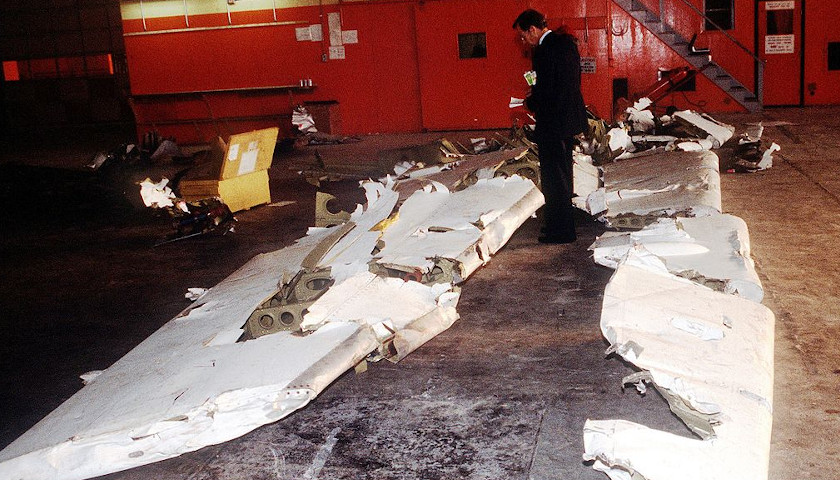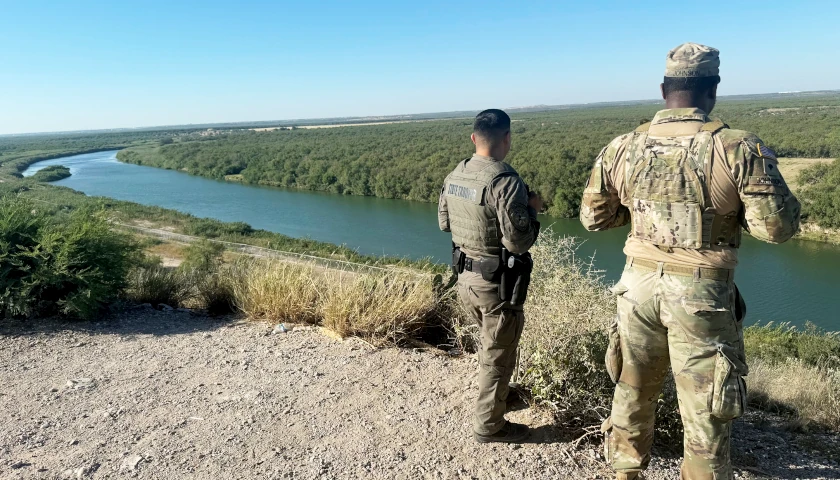Thirty-five years years later, questions remain how Arrow Air 1285 crashed into a wooded hillside in Gander, Newfoundland, with 248 soldiers from 101st Airborne Division for the final leg of their journey Cairo to Fort Campbell, Kentucky, killing all the soldiers and the eight crewmembers.
“There was catastrophic structural failure in the air and witnesses on the Trans-Canadian Highway saw the orange glow in the belly of the plane—and fire,” said Saul M. Montes-Bradley, the author of “Gander: Terrorism, Incompetence and the Rise of Islamic National Socialism,” and himself was an Arrow Air flight attendant at the time of the crash.
“The plane actually broke up in several parts—it lost the tail, the cockpit and one wing,” Montes-Bradley said.
“I was part of the crew that took the 101st to Egypt, he said. “I could have been on that flight, I just was not scheduled.”
Montes-Bradley said on that trip to Egypt at the beginning of the six-month rotation, he told an officer he admired the patch for their peacekeeping mission.
“I told him I love the logo and he pulled it off and gave it to me,” he said.
The former flight attendant and later airline executive said he still has the patch, and he is bringing it with him to today’s memorial service at Fort Campbell.
“To me this thing was and is very painful,” he said.
“Number one, one of the flight attendants killed in the crash was my fiancée,” he said. His fiancée, Stacy Cutler, trained with him in 1983.
“The rest of the crew were all friends, classmates of mine. Mikey Fowler was like a father to me, so that after the shock—because the first reaction was: ‘This is not happening.’”
A. Michael “Mikey Fowler was the flight engineer in the cockpit.
Greatest single loss of life in the history of the 101st Airborne Division
The vast majority of the 248 soldiers on Flight 1285 were attached to 3rd Battalion, 502nd Airborne Infantry Regiment, which in now part of the 101st Airborne Division’s 2nd Brigade Combat Team.
Norwegian Lt. Gen. Egil J. Ingebrigtsen, the field commander peacekeeping mission, read a statement to reporters, when he learned of the crash.
″These men gave their lives in the cause of peace,” Ingebrigtsen said.
″As force commander, I spent much time with the U.S. battalion, with these young men and women, during the last few months, and I think I certainly knew them well,” he said.
“I listened to them, inspected them, talked with them, joked with them,” the general said. “And I say they were among the finest troops I have seen in my career, both the leaders and the soldiers, and this is not eyewash, I really mean it.”
Janice Fried, who was an Arrow Air flight attendant on Cairo-to-Cologne leg of the trip, said she has never forgotten the soldiers she flew with out of Egypt.
“I loved those guys, because they were so happy they were coming home to Fort Campbell for Christmas,” she said.
The division was established in November 1918, just over a week before the end of World War II. The “Screaming Eagles” were reconstituted as airborne infantry in World War II and in the Vietnam War took on its current air assault mission.
Despite the 101st seeing ferocious combat, since its return to the inventory, including service in Iraq and Afghanistan, the loss of 248 personnel at Gander remained the division’s single greatest loss of life.
Twenty-three of the Gander crash victims are buried at Arlington National Cemetery.
Today, there is a new memorial at Fort Campbell, dedicated in 2019, after the 256 trees planted at the original memorial became too large and unruly. The new memorial has also has a tree for each of the victims.
Sergeant Joseph A. Jones, who was assigned to Headquarters and Headquarters Company, 3rd Battalion, 502nd Infantry Regiment, “Strike and Kill,” 2nd Brigade, 101st Airborne Division, was one of 248 Soldiers who died when their flight crashed in 1985. https://t.co/6oqMQoXIan
— Fort Campbell Courier (@CampbellCourier) December 11, 2020
Reagan comforts Flight 1285 families at first memorial ceremony
President Ronald W. Reagan and First Lady Nancy Reagan attended the first memorial service held Dec. 16, 1985 at Fort Campbell.
Most of the young men and women we mourn were returning to spend the holidays with their families,” Reagan said.
“They were full of happiness and laughter as they pushed off from Cairo, and those who saw them at their last stop spoke of how they were singing Christmas carols. They were happy; they were returning to kith and kin,” he said.
“Then the terrible crash, the flags lowered to halfstaff, and the muffled sobs, and we wonder: How this could be? How could it have happened, and why?” he said.
“Who else but an idealist would choose to become a member of the Armed Forces and put himself or herself in harm’s way for the rest of us?” he said. “Who but the idealist would go to hard duty in one of the most troubled places of the world and go not as a matter of conquest, but as a force that existed to keep the peace?”
As Reagan and the first lady consoled and embraced the loved ones in the cavernous hangar, a child’s plea rang out: “I want my daddy!”
Canadians blame ice on the wings for the crash, but evidence points to a bomb
The Canadian Aviation Safety Board issued two reports in 1988, the majority report signed by five members said the probable cause of the crash was the aircraft’s unexpectedly high drag and reduced lift condition, because of ice on the wings and an understated cargo weight.
The minority report dismissed ice-on-the-wings as the significant cause, and instead pointed to the all the evidence that there was an onboard explosion.
Ted West, the technician who fueled Flight 1285 at Gander said he saw no ice on the wings.
Arrow Air’s insurance company hired Irving Pinkel, an air safety consultant, who retired from the National Aeronautics and Space Administration as the director of NASA`s Aerospace Safety Research and Data Institute, to conduct his own investigation.
Pinkel walked the debris fields and found pieces of the plane with evidence of an explosion—even though the crash sites were bulldozered on the orders of the U.S. Army.
The former NASA safety czar told the Chicago Tribune in 1990, ”All I can say is there was an explosion, and in all probability, it happened while the airplane was in flight.”
Fried said she suspects the bomb was planted on the plane in Egypt, because the it was the only point of the trip when non-Americans were near the plane and handling cargo.
“I don’t think it was planted in Cologne,” she said.
“It might have been boarded in Egypt, I think on that trip, the Egyptians were loading the plane, not the Americans,” she said. “I just thought it was strange that the Egyptians were loading the plane—and I remember that had trouble loading the plane, too, because there were so many large duffel bags—it could have been overloaded, but I am not even sure about that.”
If Fried’s narrative is correct, that means she was riding on the plane with the bomb on that first leg. “God doesn’t want me yet,” she said.
Montes-Bradley said the evidence of an onboard explosion was overwhelming. In addition to the witnesses, who saw the orange burst on the belly of the plane, there were the starburst holes in the fuselage that are the signature of an explosion blast from inside.
The initial reports were already speculating that the pilots did not know how to fly in the winter conditions at Gander, he said.
This is absurd, because Gander was one of the regular fueling stops for Arrow Air crews, he said.
The problem with the bomb onboard explosion theory was that if someone killed 248 Army soldiers in a terrorist attack, there was no way the government could ignore it, he said.
Pentagon spokesman Robert Sims said, “We have no indications of explosions prior to the crash or of a hostile action.”
At the White House, Deputy Press Secretary Larry Speakes told reporters there was no evidence of sabotage. Yet, a new terrorist group called the Islamic Jihad called news agencies to take credit—and in their statement, they knew that the flight was delayed—which is why they said the bomb went off at Gander and not at Fort Campbell.
Montes-Bradley said the ice-on-the-wings theory allowed the U.S. government pretend that an act of war against the United States never happened. “They were very happy to let the Canadians bungle it.”
Flight engineer’s daughter defends her father’s precautions
Janet Fowler, the flight engineer’s daughter, said she was a 25-year-old Arrow Air flight attendant when her father was killed in the crash.
When the call came, she said she asked: “Was Dad on it?”
The voice on the other end of the phone said: “Yes.”
Upon hearing the answer, she said she threw the phone and went into shock.
Fowler said her father was an Air Force aircraft mechanic before leaving the military to become a commercial airline flight engineer.
“The other flight attendants would always tell me that Dad could put a plane together with spit and chewing gum and make it fly,” she said.
But, that did not mean he did not take safety seriously, she said. “He would never do anything that would hurt anyone or hurt the operation. He was very conscientious.”
Witnesses testified that before the one-minute flight and crash in the woods by Gander Lake, they saw her father physically inspecting the exterior of the DC-8, she said. “I know damn-well he did a walk-around. I know damn-well he was out there—he checked the wings—he did it.”
Gander crash may be tied to Arab hostility to Camp David Accords
Arrow Air was a charter airline with a number of federal government contracts for routes, such at taking U.S. soldiers to-and-from peacekeeping duty with the Multinational Force and Observers task force established as a buffer between Egypt and Israel. The MFO was part of the 1978 Camp David Accords President James. E. “Jimmy” Carter negotiated between the Middle East rivals, he said.
Israel and Egypt fought two wars, the 1967 “Six Day War” and the 1973 “Yom Kippur War,” in addition to other skirmishes. Carter facilitated 12 days of secret talks at the presidential retreat at Camp David, Maryland between Israeli Prime Minister Menachem Begin and Egyptian President Anwar Sadat.
Begin and Sadat won the 1978 Nobel Peace Prize for the accords and the agreement is the foundation of the peaceful relationship between the two countries today.
However, inside Egypt and the Arab world, the Camp David Accords were regarded as a sellout of the Palestinian claims on Israeli territory. The Arab League expelled Egypt for the next decade and the Muslim Brotherhood condemned Sadat.
Originally, the United Nations were supposed to maintain the peacekeeping mission, but opposition from Arab countries and the Soviet Union, forced the United States to take over the mission. In 1984, Leamon R. Hunt, the first American director of the Sinai MFO mission, was gunned down in Rome by members of the Red Brigades.
Less than four years after the peace treaty, members of Islamic Jihad, the same group that claimed responsibility for taking down Flight 1285, gunned down Sadat as he reviewed a military parade.
In the context of the peacekeeping mission in Sinai, the U.S. troops were seen as guarantors of Sadat’s betrayal of the Palestinians and the group that claimed responsibility, Islamic Jihad, or al-Jihad, in 1981 to avenge that betrayal.
In the summer of 2001, al-Jihad merged with Al Qaeda.
– – –





